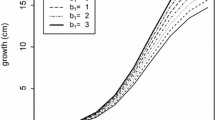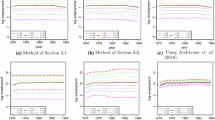Abstract
This paper considers penalized quantile regression model for random effects longitudinal data from a Bayesian perspective. The introduction of a large number of individual random effects can significantly inflate the variability of estimates of other covariate effects. To modify this inflation effect a hierarchical Bayesian model is introduced to shrink the individual effects toward the common population values by using the Lasso and adaptive Lasso penalties in the quantile regression check function. A Gibbs sampling algorithm is developed to simulate the parameters from the posterior distributions. The simulation studies and real data analysis indicate that the proposed methods generally perform better in comparison to the other approaches.





Similar content being viewed by others
References
Alhamzawi R, Yu K, Benoit DF (2012) Bayesian adaptive Lasso quantile regression. Stat Model 12:279–297
Andrews DF, Mallows CL (1974) Scale mixtures of normal distributions. J R Stat Soc B36:99–102
Arellano M, Bond S (1991) Some tests of specification for panel data: Monte Carlo evidence and an application to employment equations. Rev Econ Stud 58:277–297
Barndorff-Nielsen OE, Shephard N (2001) Non-Gaussian Ornstein-Uhlenbeck-based models and some of their uses in financial economics. J R Stat Soc B 63:167–241
Geraci M, Bottai M (2007) Quantile regression for longitudinal data using the asymmetric Laplace distribution. Biostatistics 8:140–154
Koenker R (2004) Quantile regression for longitudinal data. J Multivar Anal 91:74–89
Koenker R (2005) Quantile regression. Cambridge University Press, New York
Koenker R, Machado J (1999) Goodness of fit and related inference processes for quantile regression. J Am Stat Assoc 94:1296–1309
Kozumi H, Kobayashi G (2011) Gibbs sampling methods for Bayesian quantile regression. J Stat Comput Simul 81:1565–1578
Li H, Luo Y, Tian M (2013) Bayesian Lasso quantile regression for panel data models. J Quant Tech Econ 2:138–149
Li Z, Tian M, Luo Y (2014) Study on adaptive Lasso quantile regression for panel data models. Stat Inform Forum 7:3–10
Luo Y, Lian H, Tian M (2012) Bayesian quantile regression for longitudinal data models. J Stat Comput Simul 82:1635–1649
R Development Core Team (2011) R: a language and environment for statistical computing. http://www.R-project.org
Tibshirani R (1996) Regression shrinkage and selection via the Lasso. J R Stat Soc B58:267–288
Wang X, Song L (2011) Adaptive Lasso variable selection for the accelerated failure models. Commun Stat Theory Methods 40:4372–4386
Yang H, Liu H (2014) Penalized weighted composite quantile estimators with missing covariates. Stat Pap. doi:10.1007/s00362-014-0642-2
Yu K, Moyeed RA (2001) Bayesian quantile regression. Stat Probab Lett 54:437–447
Yu K, Stander J (2007) Bayesian analysis of a Tobit quantile regression model. J Econ 137:260–276
Zou H (2006) The adaptive lasso and its oracle properties. J Am Stat Assoc 101:1418–1429
Author information
Authors and Affiliations
Corresponding author
Appendix
Appendix
Recall that we assume the likelihood to be an asymmetric Laplace distribution, which has a hierarchical representation as follows:
Under the above expression and hierarchical model (5), the posterior distribution of all parameters is given by
where \( \varvec{s}=(s_1,\ldots ,s_n) \) and \( \varvec{e}=(e_{11},\ldots ,e_{1m_1},\ldots ,e_{nm_n})\). From the above expression, it is easy to deduce the full conditional posterior distributions of unknown parameters.
Rights and permissions
About this article
Cite this article
Aghamohammadi, A., Mohammadi, S. Bayesian analysis of penalized quantile regression for longitudinal data. Stat Papers 58, 1035–1053 (2017). https://doi.org/10.1007/s00362-015-0737-4
Received:
Revised:
Published:
Issue Date:
DOI: https://doi.org/10.1007/s00362-015-0737-4
Keywords
- Asymmetric Laplace distribution
- Bayesian quantile regression
- Hierarchical models
- Longitudinal data
- Penalty methods
- Random effects




